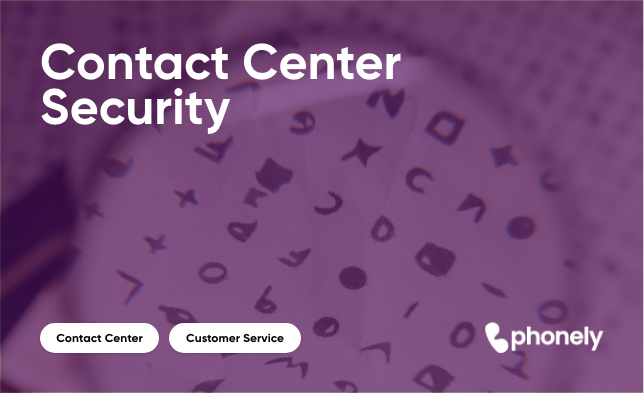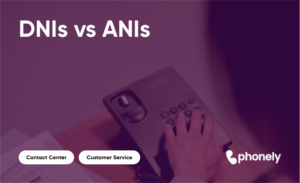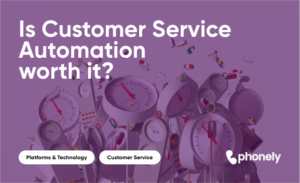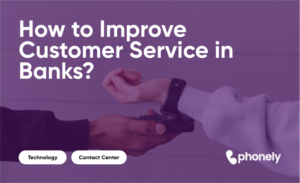Contact centers have a ton of sensitive data flowing through their communication channels. This makes them a prime target for cyberattacks. Any organization that has faced one, can expect to spend $4.45 million recovering from one. Beyond the financial loss, research shows that 31% of consumers abandon a brand after a data breach. With contact centers handling credit card details, social security numbers, and customer health records, they must protect customer data at all costs. The right defenses against these attacks can make all the difference. Our guide explores key strategies to safeguard your contact center and protect your customer data from these threats.
Top Security Risks in Contact Centers
Let’s start with the top security risks that loom over contact centers. Staying on top of these security can help you proactively tackle them.
Fraud and Account Takeover (ATO)
What is Account Takeover (ATO)?
Account Takeover or ATO is when a cybercriminal gets unauthorized access to a customer’s account primarily by exploiting security weaknesses. Once inside, the attacker takes control of bank accounts and credit card information. They would then go on to make fraudulent transactions, steal data and even impersonate a user to carry out more nefarious activities.
Social Engineering & Spoofing
Then there are spoofing and social engineering attacks, where a fraudster would trick your agents into providing information or access. Hackers usually pose as real customers or internal employees to manipulate agents over call. They try to employ multiple tactics to manipulate agents into breaking protocol and divulging information. This happened at Verizon, where agents used social engineering to steal user data. And while Verizon was able to plug all leaks, this shows that no business, big or small, is immune to these attacks.
Data Breaches
Handling PII
PII stands for personally identifiable information (Social Security Numbers, Credit Card Information, Health Records, etc.). Contact centers often have this information in their customer files and call recordings. Just last year (2023), an agent’s account got compromised and a hacker gained access to customer emails, service queries, and other shared documents. This only goes to show that the smallest failure point can lead to a widespread security breach.
Insider Threats
At Discord, the agent account was compromised because of a phishing attack, but leaks can also be deliberate. Disgruntled employees also pose a threat to security as they too can leak sensitive data. According to Verizon’s Data Breach Investigations Report, 74% of organizations feel that they are vulnerable to inside threats. In contact centers, this risk is exacerbated further as there is a high rate of agent turnover. Training and strict protocol is the only solution here.
Over the next few sections, we will see strategies and protocols that can help you protect sensitive customer data and build a trustworthy call center.
Data Protection and Access Management
Let’s start with how you can keep your data secure using a combination of tools and controlling access to information.
Encryption at Rest and in Transit
A simple way to understand encryption is to think of it as data that gets converted into unreadable formats. Only authorized personnel can then have access to it, given that access requirements are met. The data is behind a lock and only a few people have the key. Broadly, there are 2 types of encryption that contact centers must have. First, encryption at rest which means protecting data when it is stored. This includes data like call recordings, customer details, payment information, and others. Encryption in transit means protection of data when it is being transferred over networks. This could be between systems or over the internet. Without these 2 types of encryption, data is vulnerable to theft or tampering.
Tools
SSL/TLS (Secure Sockets Layer/Transport Layer Security) are the most common ways to protect data in transit. So when information travels from one system to another, only an authorized system can view the files that have been shared. In this case, that would be a system within the contact center facility itself. For remote agents, VPNs (Virtual Private Networks) can be established to securely access contact center systems.
Protection from Man-in-the-Middle Attacks
A MitM or Man-in-the-Middle attack is when a hacker intercepts communications between two parties. In such a case, even if the hacker gets the data, encryption would prevent them from being able to access this data.
These deterrents are a good start, but they alone are not enough when it comes to protecting customer data. That’s where Role-Based Access Controls come in.
Role-Based Access Control (RBAC)
Role-Based Access Control has the definition in its name. This means that employees should only have access to the data and systems that they need for their job functions. For example, an agent on the calling floor only needs the contact information of the customer. If something needs to be verified, they only need the last 4 digits of a card or SSN to authenticate the caller. Limiting this access ensures that information is only shared, on a need-to-know basis.
A recent example of lax RBAC policies comes from the Twitter Breach in 2020, where hackers specifically targeted employees with higher levels of access. They then used social engineering tactics to extract information, leading to multiple high-profile accounts being hacked.
Software Updates and Patch Management
Running outdated software is a common issue in contact centers, yes this happens. Keeping your software up-to-date is necessary to receive the latest security patches. When you delay or ignore these updates, you are effectively ringing the dinner bell for hackers and cybercriminals. Software vulnerabilities in your communication systems, databases, and internal networks can be used for data theft, denial of service attacks or complete system sabotage.
Now, several call centers use automated patch management systems that update all necessary software to their latest versions automatically. So as soon as the update is released, it gets downloaded and applied across the entire organization. Along with increased protection, this also reduces the load on your IT teams to manually update and verify the systems.
Threat Monitoring and Incident Response
AI-Powered Threat Monitoring
The methods we discussed above were only passive or reactive security measures. But safeguarding your call center’s operations takes a little more than that.
Today, Artificial Intelligence (AI) and machine learning (ML) algorithms have enabled real-time monitoring. In a nutshell, these technologies observe and analyze agent and customer activity on your platforms. This makes it possible for the tech to detect any suspicious activity and stop it in its tracks. They track network traffic, user behavior, and system activities to flag anomalies and unusual activity. This enables you, as a manager to neutralize any threat before it becomes a problem.
Platforms like Google Cloud have tools to analyze vast amounts of data for malicious activity. Microsoft’s Azure Security Center offers AI-driven insights to detect and neutralize potential threats in real time. And don’t worry about integrations, these platforms integrate with almost any infrastructure stack and offer continuous monitoring and automatic alerts. Just make sure that access to these tools is protected with the right security protocols.
Incident Response Plan
Despite all the measures in place, security breaches still happen and sensitive information gets leaked. Your approach as a leader makes all the difference in this case. To make sure that you and your organization don’t get destabilized, have an incident response plan (IRP) in place. An IRP is basically a roadmap for your organization on how to react when a breach happens. With an IRP you can react quickly, which will reduce exposure, financial damage, and damage to your reputation. Here’s a roadmap with all the basics:
- Identify the Breach: The first step is to detect and confirm that a security incident has occurred. The monitoring tools we spoke about earlier should be able to alert security teams about any suspicious activities. From there, a forensic analysis of the systems and parties involved will help determine the scope of the breach. In
- Contain the Breach: Once identified, the first priority is to prevent further damage. See what ways you can include in your IRP to implement this. In the case of a cyber-attack, you can isolate affected systems, disable compromised accounts, and block any unauthorized access points.
- Notify Affected Parties: Depending in the severity of the breach, your local/industry-specific regulatory requirements might kick in. In this case, you must notify customers, stakeholders, and regulatory bodies about the breach. Speed and transparency are the key here. To prevent legal and regulatory penalties, plan in advance on how you relay this information.
- Remediate and Recover: Once the breach is contained, shift your focus on eliminating the root cause of the breach. This could be security patches, system updates or access denials. Once the breach is resolved, then and only then, can normal functions resume.
- Post-Incident Review: After operations resume, you must have a post-incident review to seek out gaps in your call center security. This process uncovers what you can do to prevent further breaches. Since your IRP just got battle-tested, a post-incident review is a good time to review that as well.
With both active and passive security under control, let’s see how you can secure the customers who choose to engage with your contact center.
Customer-Focused Security Strategies
Transparency in Data Handling
Being upfront with customers about how and why their data is collected is the most direct way of establishing trust. When your customers know how their data is collected, stored, and used; they will feel that their privacy is also important to you. So if, god forbid, a breach happens, your customer churn will be contained. There are also compliance requirements like GDPR and CCPA that mandate you to disclose data handling practices.
A good example of this is a financial service provider sending regular reminders about setting up transaction alerts and reviewing account activity after a certain transaction. Doing this empowers the customer and this proactive approach shows them that you care about them. In this case, there’s also a reduced risk of fraud. Another example is asking users to update passwords periodically to keep their account safe.
Multi-factor Authentication for Customers
SFA of Single-Factor Authentication (password-only) is not always enough, especially when personal data is involved. That’s where Multi-Factor Authentication or MFA is required. MFA can have 2 or more ways of authenticating a user before giving them access to the account. This could include a password+one time code on their mobile devices or a biometric verification like fingerprint or FaceID. This added layer of security is a deterrent for many hackers trying to gain access to a user’s account.
High-risk transactions should always involve multi-factor authentication. Even sensitive information should be behind a MFA requirement. Incidents of account takeover and identity theft can be significantly reduced by adding one or two more steps to authenticate user identity.
Data Minimization and Masking
The best way to protect data from security threats is to not have any data in the first place. By collecting only the most essential type of data, and storing it for a short time; you can limit your own and your customer’s exposure in a breach. There are also practices like data masking, which replaces normal characters with random/unidentifiable values can also be useful.
Contact centers can also use IVR (Interactive Voice Response System) to collect sensitive information like credit cards and social security numbers. Implementing these systems prevents even your agents from seeing this information. This reduces the risk of human error or misuse. If you are worried about customer experience during these IVR interactions, try using AI IVRs to collect this information in a natural and hassle-free way.
Sophisticated technology aside, a contact center is only as bulletproof as its team. Let’s see how you can train your employees and assign security roles to prevent breaches.
Employee Training and Role Assignment
Regular Employee Training
Breaking into or hacking software is a hard task. Cybercriminals rarely possess the skills to do that. That only leaves phishing attacks, which have become widespread in the contact center industry. These attacks often trick employees into clicking a malicious link or providing sensitive data to hackers. That’s why all employees must get periodic phishing training which teaches them how to spot and avoid these threats. Employees should know what kind of attacks are becoming prevalent, and how to manage them. Some examples of this include spear phishing and business email compromise.
Other than information on phishing attacks, employees must be trained on good password hygiene and data handling protocols. Training sessions can teach employees to identify red flags in emails, like suspicious links (shortened and misspelled URLs), credential requests and strange sender’s addresses. Even employee accounts should be secured by multi-factor authentication to secure them. Employees must also be aware of their role in data handling and compliance with regulations. Violations of these protocols must be dealt with swiftly and seriously.
Clear Role Assignment for Security
Dedicated security personnel are also an asset to your contact center. Start with a dedicated incident response team, and have positions like response leaders and compliance officers on this team. They must receive training in immediate response to a breach. They should know how to contain a breach by communicating with affected parties and co-ordinating with other teams.When you assign roles and responsibilities like this, you know that your team is always on top of security concerns. And in the case of a breach, they will neutralize the threat immediately.
Security should also be a shared responsibility of all employees in your contact center. This starts with the leadership. With regular communication and ongoing reinforcement, you can empower managers, who will in turn empower their teams. When employees feel that they are an integral part of the team, they will also feel vested in customer security. This will make them more vigilant during interactions, and report any possible loopholes.
Next, let’s look at some industry-specific compliance requirements that you will have to understand and implement in your processes. Unlike other security measures, these are not optional. Here, compliance is a requirement.
Industry-Specific Compliance Best Practices
Overview of Major Regulations
HIPAA (Healthcare Industry): HIPAA short for, Health Insurance Portability and Accountability Act sets stringent data security and privacy rules. This applies to any organization that handles protected health information. Contact centers that operate in healthcare and healthcare-adjacent industries must ensure that all data is stored and transmitted securely. This includes encryption and strict access control measures. HIPAA also mandates that there must be defined protocols for handling data breaches, including timely notifications to affected individuals and regulatory bodies. Our post, HIPAA Compliant AI Phone Agents covers this in greater detail.
PCI DSS (Financial Industry): For any contact center that processes payment information, the PCI DSS of the Payment Card Industry Data Security Standard is a non-negotiable. This is essentially a standard that outlines how credit card data should be handled. PCI DSS requires contact centers to encrypt their call recordings. They should also have strong access controls and regular system testing to meet compliance. Additionally, contact centers must pass vulnerability assessments and penetration testing to detect and resolve any security weaknesses.
GDPR & CCPA: The General Data Protection Regulation (GDPR) and California Consumer Privacy Act (CCPA) are global and state-specific privacy rules to protect customer data. They both mandate that the customer (data subject) has the right to access, correct and delete their personal information. Contact centers should always entertain these customer requests, and act in specific timeframes. This means that contact centers should be able to easily locate and retrieve personal information, on demand. GDPR also strictly regulates cross-border data transfers. For large contact centers, this adds another layer of data management, to stay compliant.
Regular Auditing and Updating of Compliance
Auditing security measures is important to maintain compliance. As we just learned, some compliance measures require these audits. These audits should test encryption, access controls, and incident response plans, making sure that they are updated and effective. This also helps contact centers ensure that they comply with the latest regulatory requirements. While some of these audits are mandatory, you must never have a defensive stance on compliance and security. Your quality assessment teams should ensure that these requirements are met, while your IT team ensures that robust security measures are in place.
The Action Plan
Let’s summarize the post in the form of an action plan that you can use to set-up procedures and perform audits to target vulnerabilities.
- Assess Security Risks: Start with an internal review of your current vulnerabilities. Focus on fraud, account takeovers, data breaches, and insider threats. See what kind of attack you are most vulnerable to and then find tools to protect yourself.
- The Right Tools: Make sure that customer data is encrypted both at rest and in-transit. Regularly review access controls, and see that role based access is being enforced. Update the software where customer data is stored, and transmitted through.
- Active Monitoring: Use AI powered tools like Google Cloud and Azure Security to actively monitor agent activity. Set triggers for suspicious activity, and deal with it swiftly.
- Train the Team: Train your team by educating them on the latest tactics used by cybercriminals and how to identify them. Show them what good password hygiene looks like. Also, have a dedicated incident response team who get specialized training using simulations and drills.
- Ensure Regulatory Compliance: Administer regular audits to check for compliance with regulations like HIPAA, PCI DSS, GDPR, and CCPA. See how this regulation changes and update your policies and procedures to meet them.
Security in a contact center is a continual process. Hackers and their tactics get more sophisticated with time. To keep up, tools and compliance also follows closely behind. Having data security within your center’s culture, systems and processes is the only way to create secure contact centers.








